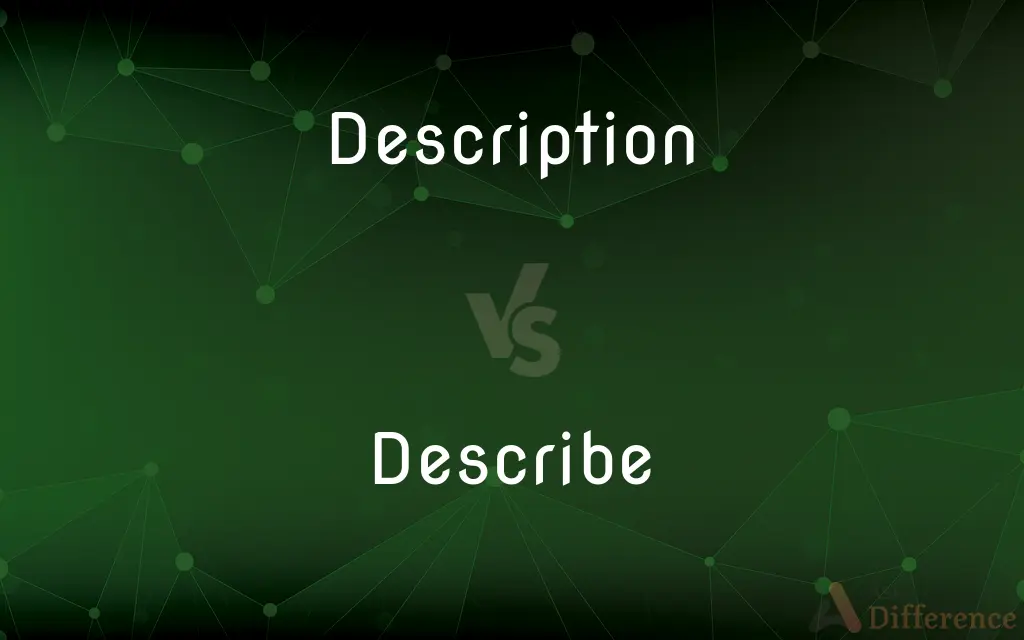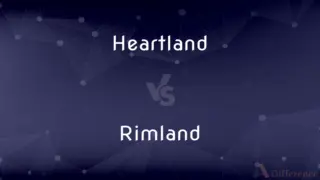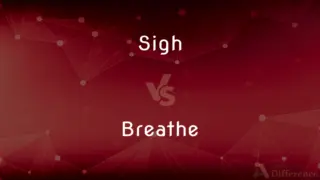Description vs. Describe — What's the Difference?
Edited by Tayyaba Rehman — By Urooj Arif — Updated on April 6, 2024
Description involves detailing characteristics or aspects of something, focusing on the depiction itself, while describe is the action of creating such a depiction through words or illustrations.

Difference Between Description and Describe
Table of Contents
ADVERTISEMENT
Key Differences
Description refers to the textual or verbal representation of characteristics, features, and attributes that define a person, place, thing, or concept. It is a static noun that encapsulates the essence of an object or scenario through detailed imagery or information. Whereas, describe is a verb that denotes the act of giving a description. It involves the process of conveying impressions, appearances, or the essence of subjects through detailed language or illustrations.
In literature, a description enhances the reader's understanding and visualization of the setting, characters, or emotions. It uses adjectives, adverbs, and figurative language to paint a vivid picture. On the other hand, when authors describe, they engage in the creative process of selecting the right words and phrases to craft these vivid images, influencing the reader’s perception and emotional response.
In academic writing, a description is often objective, focusing on providing clear, precise information about a topic without personal bias. It aims to inform or explain. Describe, however, involves the action taken by the writer to achieve this goal, requiring careful choice of language and structure to ensure clarity and accuracy.
In everyday communication, description can serve as a way to share experiences, tell stories, or relay information about objects or events. It relies on the use of sensory details and factual data. Meanwhile, when people describe something, they perform an act of communication that involves selecting the most relevant details and presenting them in a coherent, engaging manner.
The effectiveness of a description depends on the skill with which someone describes. Good descriptions are a result of attentive observation, imaginative thinking, and the ability to express thoughts clearly and vividly. Thus, while description is the end product, describe is the action that leads to the creation of this product, embodying the process and technique behind generating detailed and evocative descriptions.
ADVERTISEMENT
Comparison Chart
Part of Speech
Noun
Verb
Focus
Characteristics and details of something
The act of explaining or depicting something
Usage in Writing
Enhances visualization and understanding
Involves crafting imagery and conveying ideas
Academic Context
Objective and informative depiction
Action of providing detailed explanations
Everyday Use
Sharing experiences and information
Selecting and presenting details
Dependency
Depends on the act of describing
Leads to the creation of a description
Skill Required
Relies on the quality of description provided
Requires observation and expression abilities
Compare with Definitions
Description
Explanation of a concept or idea.
The textbook included a description of photosynthesis.
Describe
To illustrate through language.
He described his journey with such enthusiasm.
Description
A depiction in writing or speech.
His description of the event matched witness accounts.
Describe
To convey information or impressions.
The guide described the painting's history.
Description
A detailed portrayal of characteristics.
The description of the sunset was breathtaking.
Describe
To detail characteristics or appearances.
She described the thief to the police.
Description
Textual representation of features.
Product descriptions on websites help consumers make purchasing decisions.
Describe
To depict something in words.
The novel describes life in the 18th century.
Description
An account that conveys experience.
The travel blog offered a vivid description of local cuisines.
Describe
To explain the features of.
Can you describe how the app works?
Description
Description is the pattern of narrative development that aims to make vivid a place, object, character, or group. Description is one of four rhetorical modes (also known as modes of discourse), along with exposition, argumentation, and narration.
Describe
To give an account of in speech or writing
Describe a sea voyage.
Description
A spoken or written account of a person, object, or event
People who had seen him were able to give a description
Describe
To convey an idea or impression of; characterize
She described her childhood as a time of wonder and discovery.
Description
A type or class of people or things
It is laughably easy to buy drugs of all descriptions
Describe
To represent pictorially; depict
Goya's etchings describe the horrors of war in grotesque detail.
Description
The act, process, or technique of describing.
Describe
To trace the form or outline of
Describe a circle with a compass.
Description
A statement or an account describing something
Published a description of the journey.
Gave a vivid description of the game.
Describe
(transitive) To represent in words.
The feeling is difficult to describe, but not unpleasant.
The geographer describes countries and cities.
Several witnesses describe seeing lights in the sky that night.
Description
A pictorial representation
Monet's ethereal descriptions of haystacks and water lilies.
Describe
(transitive) To represent by drawing; to draw a plan of; to delineate; to trace or mark out.
To describe a circle by the compasses;
A torch waved about the head in such a way as to describe a circle
Description
A kind or sort
Cars of every size and description.
Describe
To give rise to a geometrical structure.
The function describes a very complex surface.
Description
A sketch or account of anything in words; a portraiture or representation in language; an enumeration of the essential qualities of a thing or species.
Give a verbal description of the events
A realistic description
Describe
To introduce a new taxon to science by explaining its characteristics and particularly how it differs from other taxa.
The fungus was first described by a botanist.
Description
The act of describing; a delineation by marks or signs.
Describe
(obsolete) To distribute into parts, groups, or classes; to mark off; to class.
Description
A set of characteristics by which someone or something can be recognized.
The zoo had no lions, tigers, or cats of any description.
Describe
To represent by drawing; to draw a plan of; to delineate; to trace or mark out; as, to describe a circle by the compasses; a torch waved about the head in such a way as to describe a circle.
Description
(taxonomy) A scientific documentation of a taxon for the purpose of introducing it to science.
The type description of the fungus was written by a botanist.
Describe
To represent by words written or spoken; to give an account of; to make known to others by words or signs; as, the geographer describes countries and cities.
Description
(linguistics) The act or practice of recording and describing actual language usage in a given speech community, as opposed to prescription, i.e. laying down norms of language usage.
Describe
To distribute into parts, groups, or classes; to mark off; to class.
Passed through the land, and described it by cities into seven parts in a book.
Description
(linguistics) A descriptive linguistic survey.
Describe
To use the faculty of describing; to give a description; as, Milton describes with uncommon force and beauty.
Description
The act of describing; a delineation by marks or signs.
Describe
Give a description of;
He drew an elaborate plan of attack
Description
A sketch or account of anything in words; a portraiture or representation in language; an enumeration of the essential qualities of a thing or species.
Milton has descriptions of morning.
Describe
To give an account or representation of in words;
Discreet Italian police described it in a manner typically continental
Description
A class to which a certain representation is applicable; kind; sort.
A difference . . . between them and another description of public creditors.
The plates were all of the meanest description.
Describe
Identify as in botany or biology, for example
Description
A statement that represents something in words
Describe
Make a mark or lines on a surface;
Draw a line
Trace the outline of a figure in the sand
Description
The act of describing something
Description
Sort or variety;
Every description of book was there
Common Curiosities
Why is describing important?
Describing is crucial for communication, allowing us to share detailed information, experiences, and ideas effectively.
Can you describe without a description?
No, describing is the act that leads to the creation of a description.
What is the difference between description and describe?
Description is a noun referring to a detailed depiction, while describe is a verb meaning to create such a depiction.
Is description always written?
Descriptions can be both written and verbal, conveying detailed information or characteristics.
How do descriptions differ in literature and technical writing?
In literature, they aim to evoke imagery and emotion, while in technical writing, they focus on clarity and precision.
Is it possible to over-describe?
Yes, excessive detail can overwhelm the reader and detract from the main message or narrative flow.
How does a description enhance a story?
It provides vivid imagery and details that enhance the reader's imagination and understanding of the story.
Does the quality of a description depend on the skill of describing?
Yes, effective descriptions result from good observation, imaginative thinking, and clear expression.
Do all genres of writing use descriptions?
Yes, though the purpose and style of descriptions may vary across genres.
Can a person be described?
Yes, describing a person involves detailing their appearance, personality, and sometimes actions or background.
How do descriptions affect reader perception?
They play a significant role in shaping the reader's visualization, understanding, and emotional response to the content.
Can descriptions be objective?
Yes, especially in academic and technical writing, descriptions aim to be clear and factual without personal bias.
Are descriptions necessary in technical documents?
Yes, they provide crucial information that helps in understanding complex subjects or procedures.
What role do descriptions play in visual arts?
They help in conveying the artist's intention, the context of the artwork, and its significance, enhancing viewer appreciation and understanding.
What makes a good description?
A good description is clear, detailed, accurate, and evocative, effectively conveying the essence of the subject.
Share Your Discovery

Previous Comparison
Heartland vs. Rimland
Next Comparison
Sigh vs. BreatheAuthor Spotlight
Written by
Urooj ArifUrooj is a skilled content writer at Ask Difference, known for her exceptional ability to simplify complex topics into engaging and informative content. With a passion for research and a flair for clear, concise writing, she consistently delivers articles that resonate with our diverse audience.
Edited by
Tayyaba RehmanTayyaba Rehman is a distinguished writer, currently serving as a primary contributor to askdifference.com. As a researcher in semantics and etymology, Tayyaba's passion for the complexity of languages and their distinctions has found a perfect home on the platform. Tayyaba delves into the intricacies of language, distinguishing between commonly confused words and phrases, thereby providing clarity for readers worldwide.















































